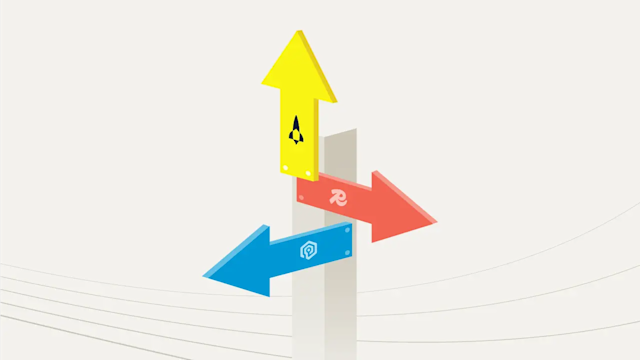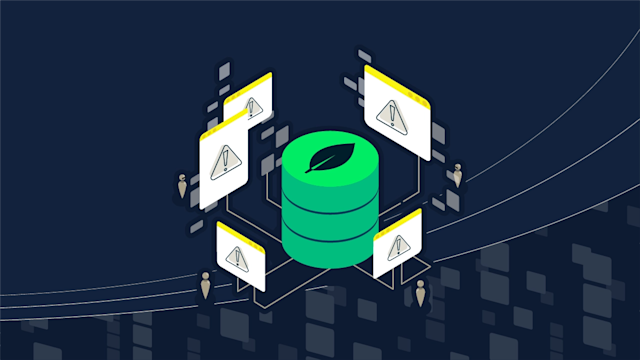Choosing between SQL and NoSQL
Choosing the right database is crucial. To make an informed decision, explore SQL and NoSQL's strengths, including structure, scalability, and performance.
Choosing between SQL and NoSQL databases hinges on differences in design and use case requirements. SQL databases are structured, relational systems designed for complex queries and transactions, maintaining data integrity through a fixed schema. They're suitable for applications requiring multi-row transactions and complex joins, such as financial systems. However, due to their monolithic nature, they may struggle with high-speed, large-scale data processing.
NoSQL databases, on the other hand, offer flexibility with schemaless data storage, making them suitable for unstructured or semi-structured data and rapid development needs. Applications may enforce a schema, similar to relational tables, on the data, but the underlying database does not require this. They excel in horizontal scaling and handling large data volumes, often used in big data and real-time web applications. NoSQL systems are designed to perform well under high throughput, often sacrificing some ACID (atomicity, consistency, isolation, durability) properties for speed and scalability.
One consideration is the application's requirements. SQL is typically preferred for structured data and complex queries, while NoSQL could be the choice for scalability and flexibility. The decision should also consider growth expectations and whether the current system architecture would support it.
SQL vs. NoSQL
Understanding the differences between SQL and NoSQL is important for database architects and IT professionals exploring database solutions that align with business needs and technological requirements. The choice between SQL and NoSQL should be guided by the nature of the data, the type of application, and the scalability needs. With this in mind, let’s dive into some specifics of each.
What are SQL databases?
Traditional relational databases, also known as SQL relational databases, are structured to recognize relationships among stored data elements. These use database schemas, a structured framework that defines tables, columns, and the relationships between them. SQL, or structured query language, stores and queries data in relational databases. This system excels in scenarios requiring data integrity and complex querying. Businesses often rely on SQL databases such as MySQL and PostgreSQL for applications requiring extensive data validation and transaction management.
What are NoSQL databases?
Non-relational databases, commonly known as NoSQL or schemaless databases, offer a flexible schema design well-suited for handling large volumes of data. Unlike a SQL database, which traditionally runs on a single node, NoSQL databases are typically deployed on a cluster of nodes, making them more scalable and fault-tolerant right from the start. Different database products are suitable for different types of applications, including document storage, key-value pairs, wide-column stores, vector search, and graph databases.
For example, systems like Aerospike are designed to manage unstructured data efficiently, deliver real-time performance, and adapt to evolving data models in big data environments. Its distributed architecture and flexibility make NoSQL a compelling choice for high-volume, rapidly evolving applications.
| Aspect | SQL database | NoSQL database |
|---|---|---|
| Data model | Relational model (tables, rows, columns) with a fixed schema defining relationships | Schemaless or flexible schema (including document, key-value, wide-column, vector search, graph, and time series) |
| Schema | Strict, predefined schema; suitable for normalized data and clearly defined relationships | Flexible or denormalized structure, designed for evolving data models and storage of unstructured or semi-structured data |
| Scalability | Typically scaled vertically (adding CPU, RAM, or storage to a single server), which can become expensive at large scale | Emphasizes horizontal scaling by adding more nodes, which is well-suited for distributing large data sets and maintaining performance; vertical scaling combined with horizontal scaling can cost less and be easier to maintain. |
| Performance | Excels at multi-row transactions and complex queries/joins; may struggle with high-speed or large-scale unstructured data | Optimized for high-speed reads/writes at scale, often sacrificing some consistency for throughput |
| Maintainability | Typically requires the database to be shut down for upgrades, leading to “downtime” windows or the need to fail over to a replica | Rolling upgrades are typically possible with no application downtime |
| Fault tolerance | A catastrophic failure of the database server typically leads to an application outage, even if brief, to fail over to a replica database | Designed to survive the loss of one or more “fault domains” with no application impact; a fault domain could be a node, a data center/AZ, or a region, depending on the database topological configuration |
| Pros |
|
|
Scaling and architecture
Scaling in databases, whether SQL or NoSQL, is important in influencing performance and its ability to adjust to changing conditions. SQL databases are traditionally scaled vertically, meaning adding CPU, RAM, or storage to existing hardware. While this approach is straightforward, it quickly becomes expensive and limited by hardware capabilities. In contrast, NoSQL databases are designed with horizontal scaling in mind. They operate across multiple servers or nodes, distributing data to be more available and fault-tolerant.
In terms of technical specifics, SQL databases manage consistency through ACID properties, providing reliable transactions for applications requiring strict data integrity. While this can sometimes introduce performance or scalability challenges, many NoSQL systems are designed with distributed architectures that offer flexible consistency models. Traditionally, NoSQL databases have used BASE (basically available, soft state, eventual consistency) principles to prioritize performance and availability across clusters of nodes. However, today’s NoSQL databases can often be tuned for strong consistency, and some even offer ACID-compliant transactions, so they can meet a wider range of application needs.
Ultimately, the choice between SQL and NoSQL should align with your business requirements, including data complexity, transaction needs, and scalability targets. Understanding these scaling and architectural nuances is important for database engineers aiming for effective database management across multiple servers.
Use cases: NoSQL and SQL limitations and advantages
When deciding between SQL and NoSQL, understanding specific use cases can illuminate the best path forward. SQL databases excel in situations requiring complex queries and transactions, making them best suited for financial systems where data integrity is paramount. NoSQL databases, however, shine in scenarios demanding high-speed processing and flexibility, such as real-time analytics, fraud detection, or content management systems.
In e-commerce, for instance, a relational database might manage transactions and inventory due to its robust ACID compliance. Conversely, a NoSQL solution could handle user-generated content or product recommendations, where rapid data retrieval and scalability are critical.
Consider social media platforms, which often benefit from NoSQL's ability to scale horizontally and manage diverse data formats. On the other hand, a relational database might be used to manage user accounts and relationships, where consistency is important.
Decision guidelines typically revolve around data structure, scalability needs, and transaction requirements. Businesses with structured data and complex relationships might lean toward SQL, while those anticipating growth and needing flexibility might opt for NoSQL. Evaluating the nature of your data, whether it's transactional or analytical, alongside future growth projections, can guide the choice between SQL and NoSQL solutions.
When to choose NoSQL over SQL
Traditionally, SQL and NoSQL have been portrayed as mutually exclusive solutions: SQL for structured, transaction-heavy workloads, and NoSQL for a scalable, flexible way to store data. However, as today’s application needs evolve, many uses traditionally solved with SQL can now be more effective with advanced NoSQL systems. Here are some scenarios and considerations that highlight when NoSQL might be the better choice:
1. Enhanced performance and scalability
Graph-style queries and complex joins: Today’s NoSQL databases now support graph-style querying, so they can perform complex joins faster and with greater scalability compared with traditional SQL solutions. This can be particularly beneficial for applications that manage interconnected data but require high performance and easier maintenance.
Built-in ACID transactions: NoSQL systems have evolved beyond their original BASE model. Many now offer ACID-compliant transactions, providing the reliability and consistency of SQL systems while benefiting from NoSQL’s distributed, scalable architecture.
2. Simplifying architecture
Eliminating the need for caching layers: If you find yourself putting a cache in front of a relational database to improve performance or attempting manual sharding across multiple replicas, it may be time to consider an advanced NoSQL solution. NoSQL platforms like Aerospike are engineered to handle these challenges natively, reducing complexity and technical debt.
Eliminate manual data sharding: Large relational database systems sometimes resort to manually dividing data between different databases to overcome vertical scalability limitations. For example, a large customer database might have customers whose last name starts with A-M in one database and those whose last name starts with N-Z in a different database. This leads to application complexity and maintenance issues, which can be avoided by using a NoSQL database.
Dynamic schema adaptation: NoSQL’s inherent schema flexibility allows data models to evolve without the downtime or complexity often associated with schema alterations in SQL databases. This is particularly useful for applications that need to adapt quickly to changing requirements or that deal with unstructured data.
3. Cost and maintenance benefits
Efficient use of resources: Advanced NoSQL databases are designed with horizontal scaling in mind, distributing both load and storage across multiple nodes more easily. This means that as your data grows, you can scale out without the capital expenses sometimes seen with vertical scaling on SQL systems. Read Vertical vs. horizontal scaling explained for more on this topic.
Reduced technical debt: Relying on workarounds like external caching, manual sharding, or complicated SQL migration scripts can add unnecessary complexity to your architecture. Migrating to an advanced NoSQL product streamlines data management by offering scalable, built-in solutions for these challenges, helping you maintain a leaner, more agile system.
The NoSQL mind shift
Transitioning from SQL databases to NoSQL requires a fundamental shift in how to approach data modeling. One of the differences is moving from the normalized schemas typical in SQL to more flexible, denormalized data structures in NoSQL. SQL databases rely on normalization to reduce data redundancy and ensure data integrity through structured schemas and foreign key relationships. In contrast, a NoSQL database encourages embedding related data within a single document or record, which performs reads faster by reducing the number of queries needed to retrieve associated data.
However, this denormalization may come at the cost of data consistency and increased complexity in maintaining data integrity across distributed systems. In scenarios where data consistency is paramount, such as financial transactions, maintaining normalized structures or using databases with built-in transactional support may be necessary.
Another aspect of the NoSQL mind shift involves querying / data retrieval. Instead of relying on complex joins and query optimizers, NoSQL often shifts to application-driven data retrieval strategies. This may involve pre-computing query results, using secondary indexes sparingly, and taking advantage of the database's native capabilities for high-volume reads and writes.
Ultimately, the transition to NoSQL demands reevaluating data modeling practices, prioritizing performance and scalability while managing the trade-offs in data consistency and complexity. This shift lets developers take advantage of the strengths of NoSQL databases, such as horizontal scaling and flexibility, to meet the demands of today’s data-intensive applications.
Use case: Data replication across data centers
Moving data between edge locations and core data centers plays a pivotal role in enhancing performance, scalability, and regulatory compliance.
The importance of data mobility
Edge-to-core architecture: Today’s applications are increasingly designed to process data close to its source at the edge, while still taking advantage of centralized resources in the core. This edge-to-core model reduces latency and improves responsiveness by processing data locally before it’s consolidated in core data centers.
Data mobility for regulatory compliance: Regulations such as GDPR and CCPA impose guidelines on data locality and protection. Effective replication strategies mean data can be stored, processed, and transferred across regions in compliance with local privacy laws and data sovereignty requirements. By dynamically managing data mobility, organizations can quickly adapt to changing legal landscapes and enforce privacy controls where needed.
Benefits of today’s replication strategies
Enhanced fault tolerance: Distributing data across multiple nodes and data centers reduces single points of failure. When disruptions occur, data remains accessible through other nodes to keep things running.
Optimized performance: Organizations reduce latency and bandwidth by processing data closer to its origin at the edge. This improved performance is essential for real-time analytics and applications that require rapid response times.
Streamlined compliance: Strategic replication provides a clear framework for meeting data governance and privacy requirements. With data managed across selected geographic locations, organizations comply with regulations such as GDPR and CCPA while still taking advantage of today’s agile architectures.
Ready to transform your data architecture?
For businesses striving to meet the rigorous demands of today’s real-time data environments, where performance, scalability, and compliance are non-negotiable, Aerospike offers a powerful solution. With its advanced edge-to-core replication strategies, Aerospike provides:
Real-time analytics: Process and analyze data at the edge to reduce latency and accelerate decision-making.
Robust compliance: Manage data across multiple data centers to meet privacy regulations like GDPR and CCPA.
Unmatched scalability: Take advantage of a distributed architecture that grows with your business, ensuring resilience and high availability.
Discover how Aerospike’s NoSQL database can power your dynamic, multi-node environments, so your data is secure, compliant, and always performing at its best. Learn more about how Aerospike can transform your data infrastructure or contact our team today.





